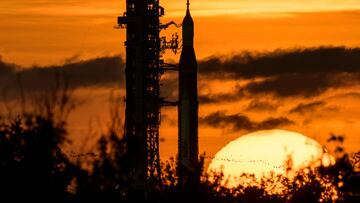When is the new launch time and date of NASA’s Artemis I flight test around the moon?
The rescheduled launch will draw eyes from all around the world as the agency takes its first tentative steps back to the moon.

The scheduled launch of the long-awaited Artemis I test flight was delayed earlier this week when NASA identified mechanical issues with the rocket and poor weather reduced the two-hour launch window.
During the fuelling of the Space Launch System (SLS) moon rocket engineers identified a temperature issue with one of the four engines and was unable to resolve the problem in time. There had been some concerns that the space agency would be forced to remove the rocket from the launch pad entirely if problems persisted, but NASA has been able to confirm a new date in the coming days.
Mission managers met on Tuesday and decided on a new date, Saturday 3 September for the launch of Artemis I. The two-hour launch window is set to begin at 2:17pm EDT.
Once again the SLS rocket will be stationed at the agency’s Kennedy Space Center in Cape Canaveral, Florida.
How can I watch the rescheduled Artemis I launch?
With the rocket launch now expected to take place on Saturday afternoon it is thought that millions of people across the United States will tune in to watch the beginnings of a new NASA program, one which could eventually aid the first humans on Mars.
As was the case with the first scheduled launch, NASA will provide live coverage of the take-off and build-up throughout the day on its own NASA TV website and the agency’s official YouTube channel.
Why was the first Artemis I launch delayed?
Thousands of spectators had gathered in the area surrounding NASA’s Florida base to watch the beginning of a new space program that hopes to return the human race to the moon for the first time in 50 years.
However the flight test, originally scheduled for Monday 29 August, was disrupted by what appears to have been mechanical faults.
An explanation on the NASA website reads: “Teams were not able to chill down the four RS-25 engines to approximately minus 420 degrees F, with engine 3 showing higher temperatures than the other engines.”
Furthermore the agency states that their team on the ground “saw a hydrogen leak on a component of the tail service mast umbilical quick disconnect,” which had to be managed manually with operators adjusting the flow of propellant to the component. Numerous reports have claimed that there was fuel visible on the floor of the launch pad.
Ahead of Saturday’s launch operators will “modify and practice propellant loading procedures” to avoid a repeat. The new procedure will mimic that of NASA’s Stennis Space Center in Mississippi.
The agency also consulted with meteorologists to decide on the optimal launch time for Saturday. The Space Force Space Launch Delta 45 team identified Saturday afternoon as the best moment for the launch, with only sporadic rain shows expected during the launch window.






